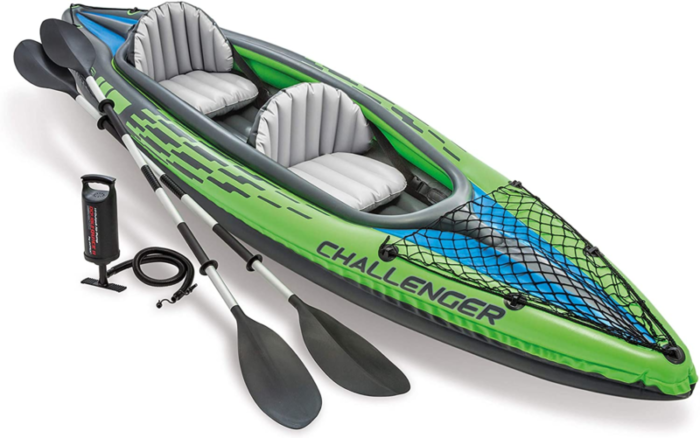What Are The Pros and Cons Of Inflatable Kayaks?

Hard shell Kayaks would always find ways to outshine inflatable kayaks considering the great benefits of inflatable kayaks. Inflatable kayaks were built for ease of carriage and with consideration for storage.
Inflatable kayaks come with advantages and disadvantages. As good as it is to only focus on the advantages, there are downsides, as there have been complaints and reviews about how bad their performances have been as well.
Inflatable kayaks, assuming we all are not fully aware of what they are; these kayaks can be folded and placed in a bag pack for easier carriage; for usage, they are inflated and then afterward deflated. The Hard shell kayaks take up space and need to be driven to the kayaking venue.
Pros of Inflatable Kayaks
- Lightweight Design: Inflatable kayaks are incredibly lightweight compared to their hard-shell counterparts, making them easy to carry to and from the water.
- Easy Deflation and Storage: Deflating an inflatable kayak is a breeze. Once deflated, it can be compactly folded and stored in a convenient carrying bag, saving you valuable space at home or in your vehicle.
- Ease of Transport: Say goodbye to the challenges of roof racks and trailers. Inflatable kayaks can fit into the trunk of a car or even a backpack, offering unparalleled convenience for transportation.
- Comparatively Lower Upfront Cost: Inflatable kayaks are often more budget-friendly than hard-shell kayaks, making them an attractive option for beginners and occasional kayakers.
- Reduced Need for Additional Equipment: Traditional kayaks may require costly accessories like roof racks or trailers, adding to the overall investment. In contrast, inflatable kayaks eliminate the need for such extras.
- Lower Maintenance Costs: Maintenance expenses are minimal with inflatable kayaks. You won’t have to worry about repairs for dented hulls or specialized cleaning products, saving you both time and money.
- High-Quality Materials: Inflatable kayaks are typically constructed from robust materials such as PVC or Hypalon. These materials are known for their durability and resistance to wear and tear.
- Resistance to Punctures and Abrasions: Inflatable kayaks are surprisingly tough and can withstand encounters with rocks, branches, and other potential hazards in the water, thanks to their durable materials.
- Adaptability for Different Activities: Whether you’re into fishing, touring, or just navigating whitewater rapids, there’s an inflatable kayak designed to meet your specific needs and preferences.
- Stability and Balance: Inflatable kayaks are generally stable, making them an excellent choice for beginners.
- Ease of Entry and Exit: Climbing in and out of an inflatable kayak is straightforward, thanks to their low sides and stable design. This ease of access is especially helpful for beginners.
- Minimal Impact on the Environment: Inflatable kayaks are gentle on the environment, as they don’t release harmful pollutants or chemicals into the water.
- Reduced Carbon Footprint During Transportation: The compact size and lightweight nature of inflatable kayaks contribute to a reduced carbon footprint during transportation, as they require less fuel for travel.
- Sustainable Manufacturing Options: Many manufacturers are increasingly adopting sustainable practices in the production of inflatable kayaks, using eco-friendly materials and reducing waste.
- Long-Lasting Construction: If properly cared for, inflatable kayaks can provide years of reliable use. Many manufacturers offer warranties, demonstrating their confidence in the longevity of these vessels.
- Suitable for Various Water Conditions: Inflatable kayaks are versatile and can be used in various water conditions, including calm rivers, serene lakes, and even the open ocean, making them adaptable for different adventures.
Cons of Inflatable Kayaks
- They are not made for high-end top speed
- They do not go well with a lot of kayak spray skirts
- Stability: You can be easily blown off when you are not a strong paddler; some do not come with leg straps or securement for the legs while kayaking.
- Durability: The inflatable kayaks are quite durable, though not as strong as a hard shell. They might not be able to take on stability in rough waters and can be susceptible to deflation when they hit rocks and other hard materials while kayaking. Depending on the brand, production material, and cost as well. Some inflatable kayaks are not as durable as would be expected.
- Pricing and Warranty: Depending on the type you buy, either the low-end or high-end inflatable kayak, bear in mind that they cost quite a bit. The company the kayak is purchased from gives the warranty, but most don’t last for more than a year or two at maximum.
- Control: They do not have as much control as you would get with a stable hard-shell kayak
- Inflation and Deflation Time: It takes extra time to inflate and set up as well as deflate and dry after usage. They cannot be safely transported when fully inflated, the best idea is to carry it along and inflate when you reach the kayaking venue. They require two people to carry and sometimes prove to be awkward during carriage on land. The paddles require breakage and assembly after and before outings.
- Comfort: Unlike a hard-shell kayak, the inflatable kayak might not give as much comfort and board space. The onboard storage space also tends to vary according to brand, shape, and sitters.
- Shelf Life/Care: Not all inflatable kayaks would be drained naturally when there’s water in the cockpit. When not properly cleaned, they are susceptible to mold. Most inflatable kayaks are made using PVC material which makes it susceptible to damage from UV rays. The high-end tend to last for up to three years depending on the company. Valves are like weak points in inflatable kayaks because they can reduce the amount of air sealed in when dirt gets in them.
- Speed: The speed of the inflatable kayak depends on the type. It costs around $1,000 to get a high-end inflatable kayak and with this, it still does not guarantee the maximum speed you expect to get from a hard-shell kayak.
- Possibility of Popping and Repair: It also has the tendency to pop or tear if not handled with care; though this can be fixed, these types of trouble come about by the purchase of a low-quality inflatable kayak.
- Width: Considering the build of an inflatable kayak, it comes out wider than a hard-shell kayak and does not hold in as much.






